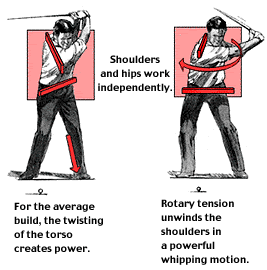THE BASIC THREE
The golf swing can be broken down into three primary sources of power: torso rotation, arm swing, and hand action. Depending on your build and flexibility, you should concentrate your efforts in one of these three areas.
SHORT AND STOUT: HAND ACTION

Players with shorter arms and limited flexibility must rely on good hand action through impact to create clubhead speed. Rather than trying to magically create a larger turn or big arc, work on maximizing your strong point. A few nuances in the grip will help. First, a strong right-hand grip, with three knuckles showing at address, gives you more freedom to hinge and unhinge the wrists during the swing. Second, pay close attention to grip pressure: The lighter you hold the club, the more active your hands will be. Third, consider slightly thinner grips, as they put more of the club in your fingers and encourage more hand action.
LONG AND LEAN: WIDER ARC

Long-limbed players should take advantage of the extra centrifugal force that can be generated by their long arms. It's called making a wide arc, and it starts with the set-up: Be sure your back is straight (tilted forward) and your chin is high rather than tucked into your chest. This enables the arms to swing and the shoulders to turn. The thought on the takeaway is to drag the club straight back along the target line.
If you can reach a fully extended position halfway back, with the clubshaft parallel to the target line, you've virtually guaranteed yourself a wide arc. From there, lift your arms to the top of the swing, as the wrists naturally hinge and the shoulders continue to turn. Creating space between your hands and body on the backswing gives you room to swing your arms on the downswing.
AVERAGE BUILD: TORSO ROTATION

Players with average builds can get extra power from effectively rotating the torso during the swing. It's not just as simple as a big turn, though. A big turn is nice, assuming the weight is firmly planted on the inside of the left foot on the backswing, but it doesn't guarantee power. Power comes from torque, the twisting motion of the torso. To create torque and whip the clubhead through impact, the shoulders and hips must work independently.

At the beginning of the downswing, your goal should be to create as much separation between the hips and shoulders as possible: As the right hip rotates through the ball, the shoulders stay wound up as long as possible. The longer the shoulders stay wound, the more separation there is between the hips and shoulders. Finally, there is so much rotary tension that the shoulders are forced to unwind, bringing the arms and club with them in a powerful whipping motion.
